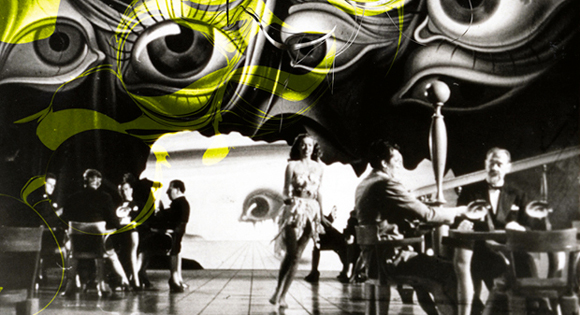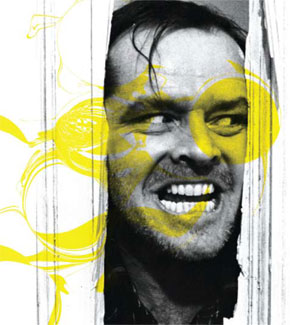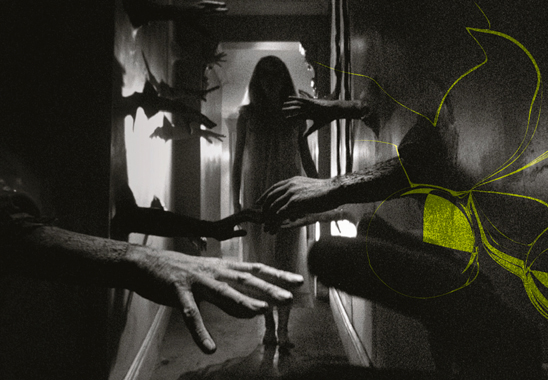
Dali’s madness in “Spellbound”
More than any other form of art, cinema lends itself to the representation of mental disorders. Paranoids, psychotics and other unsettled people fascinate or disturb the spectator because madness shatters the inherent order of the world and one’s usual perceptions of it. Cinema e loucura – Conhecendo os transtornos mentais através dos filmes [Cinema and madness – Learning about mental disorders through movies] (Artmed), by J. Landeira-Fernandez and Elie Cheniaux, is the first work to be published that systematically classifies the mental disorders of movie characters. Each chapter describes the clinical aspects of a given disorder. This is followed by cinema examples of the said disorder, which are presented and discussed. The authors discuss a total of 184 movies, many of which are well known. “The book is an academic tool for the teaching of psychopathology and psychiatry, providing concrete examples that are treated in a more abstract manner in lectures,” states J. Landeira-Fernandez, a professor at the Psychology Department of PUC-Rio. “Using movies motivates the student and is especially interesting in the case of students that have no access to actual patients,” notes Elie Cheniaux, a professor at the UFRJ Psychiatry Institute.
The relation between cinema and the psyche is evident, as the seventh art represents humans in all their forms, from the most cheerful to the gloomiest. On the other hand, the very situation in which movies are shown – a dark room in which images are projected, with a relatively passive and immobile spectator, sets an artificially regressive state that is dreamlike. This implies the individual drawing away from reality and becoming involved with its images. In the cinema, a similar phenomenon takes place. The experience of a dream, with its free associations, is comparable to cinematographic construction, which enables apparently heterogeneous worlds to coexist.
Besides these analogies, one should keep in mind that cinema and psychoanalysis, born out of psychiatry, came about almost at the same time, between the end of the nineteenth century and the start of the twentieth, revolutionizing how reality is addressed. Hanns Sachs, one of Freud’s disciples, was among the first psychoanalysts to show an interest in cinema. In his seminar, Jacques Lacan, another psychoanalysis pioneer, analyzed the main character of Luiz Buñuel’s This Strange Passion, a notorious case of paranoia.

Nicholson’s lunatic in “The shining”
“The script is based on conflict. A film, according to the classic model, has three acts: an introduction to the characters, the development of conflicts amongst them and the resolution of these conflicts, many of which are of a mental nature. A movie with ‘normal’ characters, who are at one with themselves and conflict-free, would not arouse the interest of the audience. However, a movie with disturbed characters, outside normality, depicts conflicts that drive the plot forward. A ‘crazy’ character is more cinematographic. Deviation seduces; normality does not,” argues Flávio Ramos Tambellini, professor and coordinator of the Darcy Ribeiro School of Cinema in Rio de Janeiro.
In Cinema e loucura [Cinema and madness], movie characters are regarded as clinical cases. Lost weekend (1945), by Billy Wilder, depicts very well the wealth of symptoms of abstinence from alcohol. Annie Hall (1977), by Woody Allen, presents dysthymia – characterized by depressive symptoms that are weaker than those of typical depression – as well as a generalized anxiety disorder.
However, mental disorders are often misrepresented, because movies are not educational, but follow artistic and commercial dictates. “Screenwriters and movie makers are not obliged to be true to reality. Cinema is not required to be educational. It’s an art, not a science,” Cheniaux notes. However, these distortions do not mean that the form of addressing such issues as proposed by the authors should be disregarded, to the contrary. In Ron Howard’s A Beautiful Mind (2001), a biography of John Nash, a mathematician and Nobel Prize laureate in Economics, the character’s schizophrenia is poorly described. “He has visual, kinesthetic and hearing hallucinations. This is wrong, because schizophrenics have single-mode hallucinations, of which the hearing type is the most common one. Actually, this was the only form of hallucination that Nash suffered from. Though wrong, the representation of the symptom works as a negative example,” says Landeira-Fernandez.
In other cases, the character’s behavior does not fit any diagnostic category. Frequently, this “madness” reflects common sense and is very different from the symptoms of a real mental patient. The book also includes movies with such distortions. In Roman Polanski’s Repulsion (1965), Carol, the character played by Catherine Deneuve, has a horror of penetration and behaves in a very strange way. What mental disorder might these characteristics show? Carol’s disturbances do not fit the categories described by the DSM-IV-TR, the Diagnostic and Statistical Manual of Mental Disorders, which guided the authors.
The problem of diagnosis, however, is far from being specific to movies. “In medicine, diseases are defined based on their causes. However, in psychiatry the categories are described only by their symptoms, a fact open to criticism. Often a given patient meets the diagnostic criteria for more than one category of disorder at the same time. It is difficult to believe that he has three or four psychiatric illnesses at the same time. So things are arbitrary, to some extent,” states Cheniaux.

Scene from “Repulsion”
In the first decades of the last century, those who were “mad” were generally limited to the fantastic kind and were, in general, criminals. With Robert Wiene’s German expressionism classic, Das Kabinett des Doktor Caligari, madness enters cinematographic representation. As in other expressionistic movies, the sets were strongly stylized and the abrupt gestures of the actors symbolically translated the mentality of the characters and the state of their souls. Caligari is a mad doctor that hypnotizes Cesar, his assistant, to drive the latter to commit crimes, which reflects a paranoid need for power. Another perverse and intelligent figure of that time is the central character of Fritz Lang’s Dr. Mabuse (1922), a psychiatrist that also resorts to hypnotism to manipulate people and commit his crimes. Mabuse is devoured by the desire to govern by money, whereas Caligari’s thirst for power is abstract. Mabuse’s madness and the morbid passivity of his victims point to the decadence of German society at the time and to the chaos that was overtaking the country.
Another Fritz Lang movie, M (1931) focuses more realistically on the psychology of its characters. The central figure is a murderer of girls who, however, is depicted with humanity in the horror he commits. Nevertheless, society is no better: in the face of the police’s inability to arrest him, he is “judged” by other delinquents, pointing to what was to come true in Germany in just a few months, when the Nazis rose to power.
As from the 1940’s, the media gives more room to psychoanalysis. The psychoanalytic thrillers now appear, resorting to the psychoanalysis arsenal clumsily and naively. The prototype of such movies is Alfred Hitchcock’s Spellbound. Constance (Ingrid Bergman) is a young psychiatrist in an asylum who falls in love with the new director. However, she soon realizes that the man she loves (Gregory Peck) is mentally ill and is pretending to be Dr. Edwards. Based on the sick man’s dreams and a session of analysis, Constance discovers that he has lost his memory and understands why he had shouldered the burden of guilt for a crime he had not committed: he had witnessed the death of the true Edwards, murdered by the asylum’s former director, just as he himself, during a game as a child, had pushed his younger brother to his death. Besides anguish in the face of madness, the movie depicts that anguish of madness, showing the character’s fear through dreams (drawn by Salvador Dalí) that reveal a world full of hallucinations and symbols supposedly produced by the unconscious. In this and in other movies of the period, psychoanalysis is reduced to a method that can solve obscure conflicts by deciphering a set of generally clear signs.
Starting in the 1950’s, under the impact of the horrors of World War II, movies began questioning the confinement of mental patients. Concurrently, new psychiatric drugs appeared, causing severe side effects, which led many patients to refuse treatment. In reaction to psychiatry at the time, anti-psychiatry arose and grew during the 1960s, when counterculture peaked. Some movies show this moment very well, such as Family life (1971), by Ken Loach, A woman under the influence (1974), by John Cassavetes, and One flew over the cuckoo’s nest (1975), by Milos Forman, criticizing society, which chose to confine its mentally ill people, offering them only the straitjacket, electric shocks and drugs, rather than helping them to mitigate their suffering,
These movies reflect a new view of cinema regarding madness, with more concern about the burden of society upon individuals. Some of them question the “madness” of this society and of the family, raising the issue of normalcy.
The great precursor of this line of movies is Ingmar Bergman, one of whose obsessive themes was madness. Despite the transformations of the representation of madness in cinema, most movies continue to banalize madness, with old clichés that turn the mentally ill into criminals in thrillers or fools in comedies.
Republish